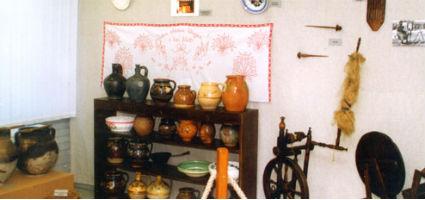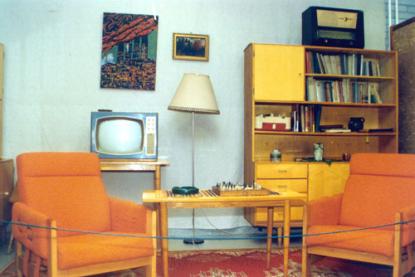2024. November 23. Saturday
Derkovits Cultural Center and Town Library - Region Historical Collection - Tiszaújváros
 |
Address: 3580, Tiszaújváros Széchenyi út 37. (Hamvas Béla Városi Könyvtár)
Phone number: (49) 542-006, (49) 542-011
E-mail: levaifanni@tujvaros.hu
Opening hours: Tue 10-19, Wed-Thu 10-17, Fri 10-19, Sat 9-13
|
Tiszaújváros is situated in the south of Borsod-Abaúj-Zemplén County, close to the mouth of the River Sajó. The land is just like those situated along rivers: its geography was modified by water. The rich flora and fauna in the floodplain, the land watered by the river Tisza and the climate of The Great Hungarian Planes was favorable for our ancestor to settle down in the region.

The first part of the exhibition is an introduction after which the visitors may peep inside a clean room in Szederkény in the 20th century. Walking on, the visitors find themselves in a fair in Szederkény among typical products of south Borsod: pottery, wooden bowls, bowls made of hey and cane, as well s honey cakes. The next block shows the history of the town we know today. The first step of industrialization was the building of a thermal power plant, which led to the building of chemical factories.
Parallel with the construction of the Tiszai Chemical Factory, building of homes for the settling workers began. Workers occupied the first homes in 1957. Those who moved in from the villages gradually left tools and equipment they had used in the villages behind and began to lead the life of towns people. The changes of lifestyle began in the 60's which is demonstrated by the interior of a flat at the exhibition.
Walking on, the visitors see participants of parades on Mayday carrying banners, as well as children dressed as pioneers. The village developed parallel with the development of the factory. The Board of Presidents declared the village town on 31 March 1966. 1970. On 22 April, on the 100th anniversary of the birthday of Lenin the town took on the name of Lenin, thus it was called Leninváros until 1 February 1991. The following two wards show two charters along with relics from the political movements in the 60 and 70's.
After the change of regime, the name of the town was changed back to Tiszaújváros and the names of streets invoking socialism were also modified. In the second half of the 1980's a family home and church construction fervor began which lasts still nowadays. The interior we show faithfully mirror the spreading of means of communication and the changes in lifestyle. The last unit presents documents of cultural and sport life.
Csesznák Ildikó

The first part of the exhibition is an introduction after which the visitors may peep inside a clean room in Szederkény in the 20th century. Walking on, the visitors find themselves in a fair in Szederkény among typical products of south Borsod: pottery, wooden bowls, bowls made of hey and cane, as well s honey cakes. The next block shows the history of the town we know today. The first step of industrialization was the building of a thermal power plant, which led to the building of chemical factories.
Parallel with the construction of the Tiszai Chemical Factory, building of homes for the settling workers began. Workers occupied the first homes in 1957. Those who moved in from the villages gradually left tools and equipment they had used in the villages behind and began to lead the life of towns people. The changes of lifestyle began in the 60's which is demonstrated by the interior of a flat at the exhibition.
Walking on, the visitors see participants of parades on Mayday carrying banners, as well as children dressed as pioneers. The village developed parallel with the development of the factory. The Board of Presidents declared the village town on 31 March 1966. 1970. On 22 April, on the 100th anniversary of the birthday of Lenin the town took on the name of Lenin, thus it was called Leninváros until 1 February 1991. The following two wards show two charters along with relics from the political movements in the 60 and 70's.
After the change of regime, the name of the town was changed back to Tiszaújváros and the names of streets invoking socialism were also modified. In the second half of the 1980's a family home and church construction fervor began which lasts still nowadays. The interior we show faithfully mirror the spreading of means of communication and the changes in lifestyle. The last unit presents documents of cultural and sport life.
Csesznák Ildikó
